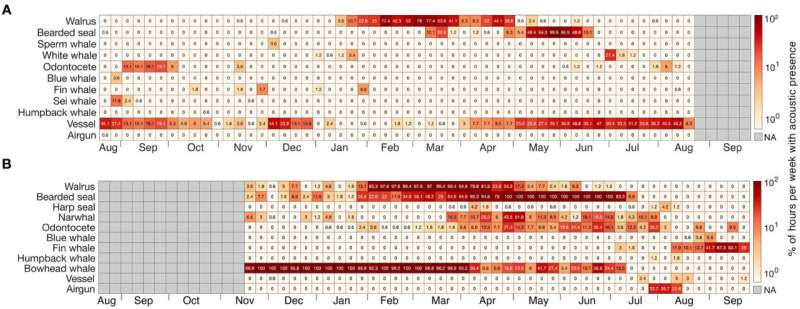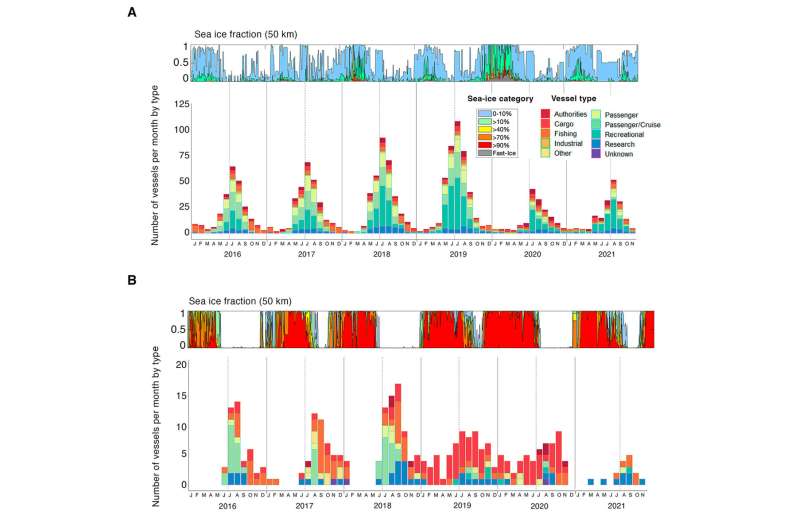November 6, 2023 feature
This article has been reviewed according to Science X's editorial process and policies. Editors have highlighted the following attributes while ensuring the content's credibility:
fact-checked
peer-reviewed publication
trusted source
proofread
Arctic Ocean soundscapes reveal changes in mammal populations in response to climate change

While the sounds of our oceans may be familiar to us through the lens of nature documentaries, from the haunting calls of whales to the barks of some fish, this acoustic environment can provide a wealth of knowledge to scientists regarding the complex interplay of nature and humanity. Not only this, but ocean soundscapes can record environmental changes, hinting at the ever-evolving underwater world and its response to climate change.
New research, published in Frontiers in Marine Science, has focused on the Svalbard Archipelago, Norway, an important Arctic location that has experienced increasing temperatures and declining sea ice over recent decades. The influence of this "Atlantification" has affected the primary production of microscopic organisms in the ocean, which filters up the trophic food chain to higher-level organisms like marine mammals.
The region's response to rapid warming has been investigated through the use of specialized marine microphones. Between 2017 and 2020, two coastal locations (Kongsfjorden to the west and M2 in the east, 50 km south of Kvitøya) recorded the soundscapes of the archipelago, documenting the occurrence, type and breeding cyclicity of marine mammals.
In particular, these two locations provide an interesting comparison as at M2 Arctic-like conditions persist with cold polar water and drifting sea ice for most of the year and approximately half the area covered in the peak months of March–April. However, Kongsfjorden is experiencing rapid change due to global warming and the influx of warmer, saltier Atlantic Water reducing sea ice concentration, thus provides an indication of how marine mammals may behave in the decades to come as their ambient environment alters.

Samuel Llobet and colleagues at the Norwegian Polar Institute used special hydrophones attached to stationary moorings, capable of recording frequencies of 10–16,384 Hz within a 30km radius, to produce spectrograms, a visual representation of the sound waves. The archipelago's soundscape was a combination of geophonies (ambient sounds from the natural world, such as from wind and ice calving), biophonies (from biological organisms, like marine mammals) and anthropophonies (noise from human activities, for example tourism cruises, fishing boats and the exploitation of natural resources).
Eleven marine mammal species were detected throughout the project, five being endemic to the Arctic (bowhead whales, narwhals, white whales, bearded seals and walruses), plus regionally migrant harp seals and five seasonally migrant whale species (sei whale, fin whale, blue whale, humpback whale and sperm whale).
The researchers found a considerable difference in the soundscapes of the archipelago between east and west. M2 experienced most noise from sea ice movement and Arctic marine mammals with occasional cargo vessels, while Kongsfjorden was predominantly sounds from glacier melt and anthropogenic tourism boat activities (>10 vessels per day May–September, peaking at >20 in July–August), with less biophonies.
Arctic species of marine mammals were detected throughout the year in the east with few migratory species (4 out of 8 being endemic to the Arctic), while Arctic species were present in all seasons except autumn in the west (eight species total, three being Arctic), where a larger number of seasonally migratory species were noted through summer to early winter.
In Kongsfjorden, the scientists also observed changes is breeding patterns, with bearded seals having a short vocal season compared to previous studies in the 1990s and early 2000s, suggesting reduced mating activity in the fjord, in line with the seasonal disappearance of drift ice.
Increased noise pollution from geophonies and anthropophonies pose a concern for the survival of marine mammals who rely upon soundscapes for long-distance communication, navigation and finding food. Species such as narwhals are particularly sensitive to noise in their ambient environment, and this study found that they stopped calling at the same time as air gun use began in the fjord.
Previous research has demonstrated that disruption of these critical life functions has had measurable impacts on calling rates and observance of avoidance behavior, such as bearded seals which are known to be able to increase the amplitude of their vocal calls in response to enhanced environmental noise but only up to a threshold point at which they stop. Indeed, Llobet shared a personal experience of kayaking off the coast of Longyearbyen, Svalbard, and recording the sounds of a cruise ship entering the area 2km away.
"Humans have engineered all sorts of inventions but we did not think about what was going on underwater. Noise is one big problem to tackle in our oceans. We all introduce noise when using boats, even the electric ones, as the propeller blades braking bubbles is one of the main causes of noise. We have to solve this together and find more silent solutions."
Llobet offers the following warning about the future of our oceans after observing the distinct vocalizations of marine mammals who avoid overlapping the calls of other species. "This is a feature of well-preserved soundscapes, a feature that might not last much longer if the boat traffic is not regulated in the region. The west coast already shows the clear influence of boat traffic in the soundscape, and the east coast might follow this trend as the ice continues to retreat and human activities expand Northeast in the Barents Sea shelf.
"It has been an amazing time listening to these wonderful creatures and getting behavioral insights as part of my job, and contributing to the first comprehensive underwater soundscape study of the region that will serve to monitor the change that is coming in the following years."
As the increase in anthropogenic trade and tourism vessel encroachment in the west of the fjord is enabled by declining sea ice, site M2 may be considered an indication of where the entire fjord, and other regions of the Arctic more broadly, may be heading in the future as humanity continues to explore and exploit these more hostile climate regions. This research highlights only the tip of the metaphorical iceberg for the impact both natural and anthropogenic noise will have on the previously pristine Arctic marine environment and its inhabitants.
More information: Samuel M. Llobet et al, The Arctic and the future Arctic? Soundscapes and marine mammal communities on the east and west sides of Svalbard characterized through acoustic data, Frontiers in Marine Science (2023). DOI: 10.3389/fmars.2023.1208049
Journal information: Frontiers in Marine Science
© 2023 Science X Network


















